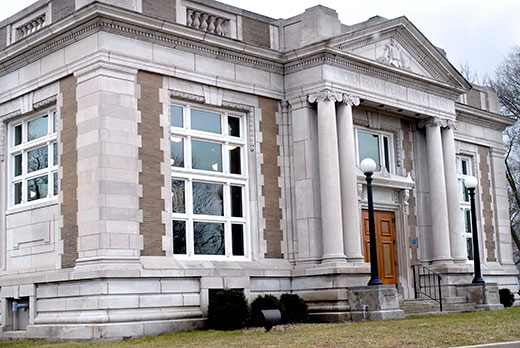
The Lincoln Library, a branch of the Peoria Public Library, opened in 1911, and was placed on the National Registry of Historic Places by the National Park Service in 2014. Andrew Carnegie helped fund the original library built in the Neoclassical Revival style with ionic columns, strong quoins and a prominent front pediment.
More than 91% of employees at the Peoria Public Library are living “paycheck to paycheck,” according to a survey of staff this winter. What’s arguably worse for them — and maybe embarrassing for the City of Peoria and taxpayers – is that 16.2% of them rely on public assistance such as SNAP food stamps, Medicaid or other social services, and 13.5% have second jobs to supplement their household incomes.
Across the country, the number of employees living paycheck to paycheck is rising, according to Lending Club, a financial services company: 64%, or about 9 million Americans forced to dip into their savings or rely on credit cards. Recent data from the Federal Reserve Bank of St. Louis shows that Americans’ personal savings rate dropped to 2.4% in November, compared to 7.1% from the same time last year.
The survey generated 37 responses out of 60 employees represented by the American Federation of State, County and Municipal Employees (AFSCME), which conducted the survey so employees could respond anonymously. That’s a return rate of 61%, far better than the norm for employee surveys, which typical result in average returns of 41.2% and median (midpoint) returns of 26.4%, according to CustomInsight, a U.S. firm that designs and administers surveys.
Already, local-government employees in the United States have weekly earnings 14.1% lower than similar occupations for private employers, according to Economic Policy Institute (EPI) – despite many being better educated..
“Though public-sector workers have more generous benefits, these benefits do not make up for lower wages and salaries for most workers,” reported EPI’s Monique Morrissey and Jennifer Sherer in a 2022 study using Census data. “Low pay is a key factor driving the staffing crisis facing schools and other units of state and local government.”
Local government employees include teachers, police and firefighters, but also staffers at libraries, museums, and other cultural institutions; courts and corrections; child care, health care, and social services; public utilities, transportation, and sanitation; parks and recreation; housing and environmental protection; and legislative bodies and executive offices, EPI notes.
For them, the pay gaps are especially burdensome for those with college degrees — and student loans. Further, local-government workers are more likely to have college degrees than private-sector employees, with 29% holding bachelor’s degrees compared with 25% of private-sector workers, and 31% having earned advanced degrees compared to 12% of those working for private companies, Census data show.
The pay gap has widened since 2010, when the National Institute for Retirement Security reported that public employees nationwide earned an average of 12% less than their private-sector counterparts. (In Illinois, the local gap was wider: 13.3% less.)
Of course, few private-sector jobs are exactly like library work, so in some ways library employees have fewer opportunities to take their training and talents to private employers, unlike teachers and other professionals.
Other survey findings show that Peoria’s library employees are:
* 52.8% parents or caregivers for others,
* 44.4% insecure about their housing,
* 86.4% insured for health care for themselves or their families, and
* 83% full-time.
